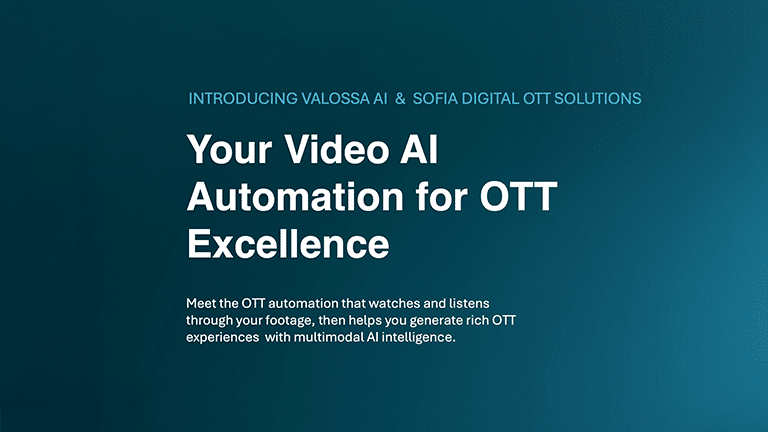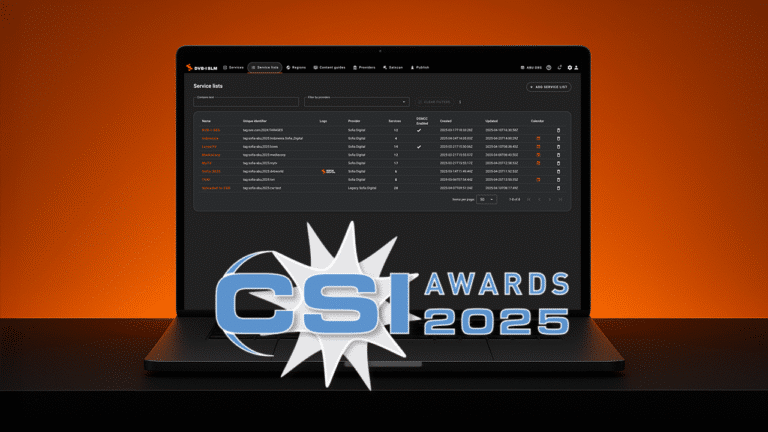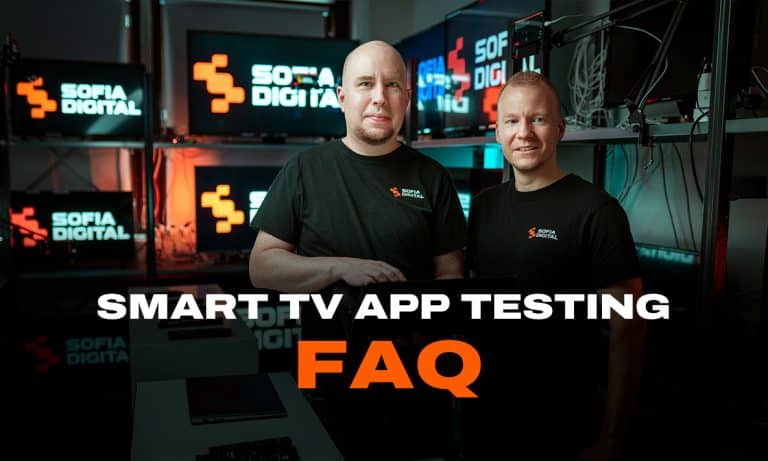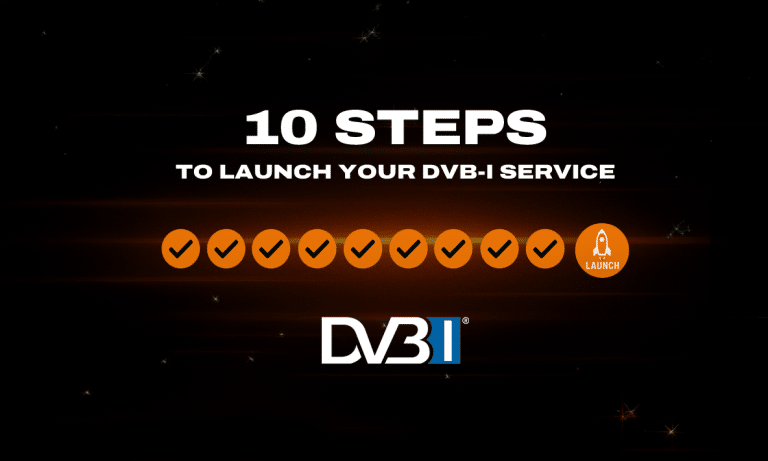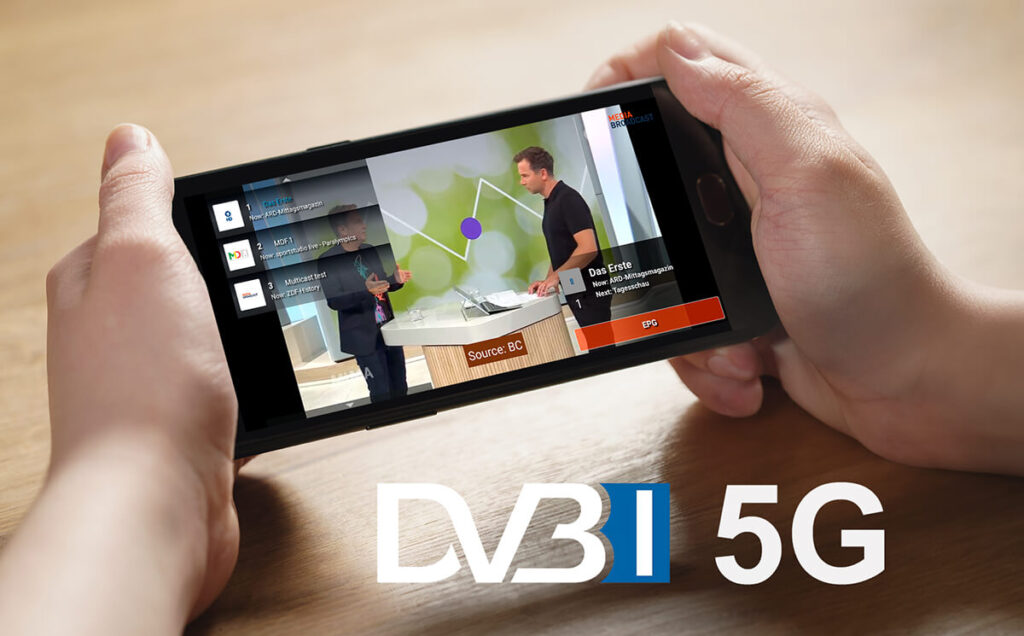
As broadcasting seems to migrate into an all-IP-based network, the business requirements for robust and simple scaling solutions become essential. Two important new complementary elements of DVB-I and 5G Broadcast offer a fresh approach to an old peak capacity problem, offering reliability and reach.
DVB-I offers a standardized way to describe and discover television services across different networks and devices. It is transport-agnostic, meaning it can work equally well over broadband, broadcast, or mobile networks. Meanwhile, 5G Broadcast introduces a new method for delivering live and linear content using mobile network infrastructure, without relying on one-to-one unicast connections or even requiring a SIM card.
This article examines exactly how these two technologies fit together. DVB-I will specify how services are structured and come to screens, while 5G Broadcast adds another layer of efficient delivery. Together, this has the potential to bring modern content distribution in a scalable and flexible way, especially in scenarios where traditional broadcast or broadband infrastructure alone may be inadequate. If you’re new to DVB-I, we recommend reading our What is DVB-I? article for an overview of the standard and its key concepts.
What Is 5G Broadcast and Why It Matters for TV Delivery?
5G Broadcast is a one-to-many delivery model that enables live or linear video content to be distributed via mobile network infrastructure without creating a connection with every single user. In contrast to conventional unicast streaming, in which each viewer gets an independent data stream, 5G Broadcast delivers identical content to all users at the same time over the same network resources.
The technology builds on previous efforts, including LTE’s eMBMS enhanced Multimedia Broadcast Multicast Service, but 5G Broadcast introduces essential improvements in performance, flexibility, and standardization. A critical feature is that it operates in a network-agnostic fashion. This would mean devices can receive 5G Broadcast transmissions without the use of a SIM card or mobile data plan, making it ideal for public or free-to-air content, and simplifies the possibility of receiving the signal in “SIM-less” environments like cars, ships, community spaces and boats.
From a spectrum efficiency perspective, this model is particularly valuable for large-scale content delivery. Peak events such as sports, elections, or emergency broadcasts can reach thousands or millions of viewers without putting strain on mobile networks or requiring extensive CDN infrastructure. Instead of duplicating traffic for each viewer, a single transmission is enough, no matter how many people are watching.
As mobile video consumption is on the rise, 5G Broadcast delivers a new means of delivering TV-like services to smartphones, tablets, and other handheld devices. For network operators and broadcasters, it presents a new delivery path that complements existing infrastructure rather than replacing it.
The Role of DVB-I in a 5G Broadcast Environment
While 5G Broadcast provides the physical delivery infrastructure for achieving it cost-effectively, DVB-I has the critical role of deciding how services are presented, discovered and consumed by the end user. It is the service layer on top of any network for distributing services like broadband, broadcast or mobile, and offers a single viewer experience regardless of device or platform.
DVB-I makes it possible to use structured service discovery based on standardized metadata. This provides a means for compatible devices to find available services, access program information, and offer an integrated electronic program guide regardless of the delivery of the content. In a 5G environment, this would mean that services broadcast over a broadcast channel are as easily discoverable as services delivered over broadband or other IP-based approaches.
Another advantage of DVB-I is the convergence of multiple delivery modes. A viewer can begin watching a service on 5G Broadcast and resume it on broadband in case of loss of coverage. DVB-I can enable this kind of hybrid delivery through management of fallback mechanisms and provision of a unified service identity on the networks.
In this way, DVB-I makes 5G-delivered content feel like part of the same television environment users already expect. It allows broadcasters and operators to focus on content and service quality while DVB-I handles the logic for access, discovery and user experience.
Benefits of Combining DVB-I and 5G Broadcast
When DVB-I and 5G Broadcast are used together, they create a flexible delivery model that can serve both fixed and mobile audiences without depending entirely on broadband infrastructure. This combination offers several advantages for broadcasters, network operators, and end users.
One of the main benefits is scalability. 5G Broadcast allows the same content to be delivered to a large number of users without duplicating data streams. During high-demand events like sports finals or live news coverage, this reduces network congestion and makes delivery more efficient. DVB-I supports this by providing a consistent method to describe and access those services across different networks.
DVB-I enables service providers to show a single lineup of channels and programs, even where the content is distributed via a combination of 5G Broadcast and broadband. The viewer doesn’t have to care which network they are using. They just consume services via a familiar user interface that hides the technicalities.
For operators, this approach can help lower infrastructure and distribution costs. Since DVB-I does not require a dedicated app or proprietary platform, it reduces development and maintenance efforts. Combined with the broadcast efficiency of 5G, this supports a more sustainable and future-ready delivery model. With a recent and updated mobile device, rolling out a DVB-I/5G BC experience for consumers does not require a mammoth effort.
Another benefit is flexibility in device support. DVB-I is designed to be used on smart TVs, phones, tablets, and other connected devices. As support for 5G Broadcast expands, these devices can take advantage of hybrid delivery without needing special configurations. This allows broadcasters to reach mobile audiences with reliable linear services, using infrastructure that scales with demand.
Real-World Use Cases
While 5G Broadcast and DVB-I are still in the early stages of large-scale deployment, several use cases are already demonstrating their combined potential. These scenarios show how the technologies can support modern viewing habits and extend service reach beyond traditional TV environments.
One example is an actually working mobile live TV. With DVB-I managing service discovery and 5G Broadcast dealing with distribution, users can access linear television services on their smartphones and tablets without installing separate apps or using mobile data. This can be particularly useful for public events or in areas where broadband capacity can’t cope.
In-vehicle infotainment is another emerging use case. As new cars are already connected, there is a growing demand for reliable and high-quality media services. DVB-I combined with 5G Broadcast allows vehicles to receive live television or news services directly, with DVB-I providing the interface and service logic needed to browse and access available content.
Public information services also benefit from this model. Emergency alerts, weather warnings or public announcements can be distributed via 5G Broadcast with DVB-I ensuring the information is properly categorized and made available to end users across devices. Since 5G Broadcast can reach devices without active subscriptions, this approach increases accessibility and resilience during times of crisis.
Trials and demonstrations in countries such as Germany and Italy have already explored how 5G Broadcast can be used to deliver TV services. As support grows, more broadcasters and network operators are looking into how DVB-I can provide the necessary structure and control to make those services easy to use and widely available.
Technical Considerations
While the combination of DVB-I and 5G Broadcast offers clear benefits, there are also technical factors that need to be considered before large-scale adoption becomes practical. These include device readiness, network availability, and service integration.
Device support is a key requirement. Although DVB-I is designed to work on a wide range of devices, support for 5G Broadcast is still limited. Only a small number of commercial devices currently include the necessary hardware and software to receive 5G Broadcast signals. Until these changes, service reach may remain restricted to testing environments or specialized hardware.
On the network side, 5G Broadcast requires dedicated infrastructure and spectrum allocation. Mobile operators need to utilize broadcast-capable transmitters and ensure coverage areas are sufficient to support expected use cases. This adds complexity compared to traditional mobile broadband services and may require coordination between broadcasters and telecom providers.
Service integration also presents challenges. While DVB-I is designed to unify access across networks, implementing seamless fallback from 5G Broadcast to broadband requires careful planning. Service lists, metadata and player behavior all need to be aligned to maintain a consistent user experience as devices move between coverage areas and different delivery methods.
Another consideration is content protection. Broadcast delivery models require different rights management approaches than unicast streaming. Service providers need to ensure that existing content agreements and licensing models are compatible with one-to-many delivery, especially when reach extends to devices that do not use traditional authentication or subscription systems.
Although these technical issues do not prevent progress, they are indicative of industry collaboration and the need for careful implementation planning; certainly, more will occur as the ecosystem matures.
The Path Forward
As interest in hybrid delivery grows, DVB-I and 5G Broadcast are gaining attention from broadcasters, network operators and regulators. While both technologies are already functional, their combined potential will depend on further ecosystem development and industry alignment.
One area of focus is device support. For DVB-I and 5G Broadcast to reach a broad audience, manufacturers need to include support for both in the consumer devices. This requires collaboration across sectors, including chipset vendors, operating system developers, and hardware manufacturers. We have explored what it means to be DVB-I ready in more detail in our DVB-I Ready article.
Standardization also comes into play. DVB-I is already open spec, but its incorporation into 5G Broadcast delivery models requires additional guidance and profiles to guarantee platform-consistent behavior. This is provided by the on-going 5G MAG and 3GPP work, developing real-life examples, cookbooks and demonstrations for compatibility with ever evolving mobile network capabilities.
Business models will be involved in adoption. For broadcasters, 5G Broadcast presents a fresh means of delivering content cost-effectively. For mobile operators, it presents the potential to deliver media services without congesting data networks. Defining well-defined roles and value-sharing models between such players will be imperative.
Regulatory support may be needed to declare spectrum for 5G Broadcast and encourage its use in public service contexts. In some regions, national trials or pilot projects are already underway, providing a foundation for broader deployment.
As these technical and commercial pieces come together, DVB-I and 5G Broadcast have the potential to reshape how television services are delivered, discovered and consumed across both fixed and mobile networks.
Conclusion
DVB-I and 5G Broadcast are not alternative technologies but complementary tools for different parts of the challenge created by content delivery. DVB-I is looking at providing one structure for organization, description, and discovery across devices and networks. 5G Broadcast introduces scalable delivery mechanisms that are well-suited for live content and wide area coverage.
Together, they offer a path toward more efficient, flexible, and device-neutral television services. While there are still practical challenges to address, the foundation is already in place. Broadcasters, operators and technology providers now have the opportunity to build on that foundation and bring hybrid TV services to new audiences and use cases.
If you’d like to review DVB-I delivery options or learn how these technologies might be relevant to your service, we invite you to contact us.
Sofia Digital Is Experienced with DVB-I and 5G
Sofia Digital has combined DVB-I and 5G Broadcast technologies through its development of a DVB-I Android application for Media Broadcast in Germany. The original application, created in 2023, provided Android TVs and smartphones with DVB-I service list access and EPG data using Sofia Digital’s DVB-I backend.
Building on this foundation, Sofia Digital expanded the application to support 5G Broadcast integration. The updated version allows devices to play back video using a 5G broadcast signal after initially retrieving service information over the internet. It also includes automatic fallback to IP delivery when the broadcast signal is unavailable. This approach demonstrates how DVB-I can serve as a control and discovery layer while 5G Broadcast handles scalable content delivery.
The application was tested with commercial smartphones and developed using a controlled 5G test environment in collaboration with Media Broadcast, Rohde & Schwarz and TestTree. The project highlights Sofia Digital’s ongoing role in advancing real-world DVB-I implementations, particularly in emerging delivery contexts like 5G. You can read more about the project here.
If you are exploring DVB-I, 5G Broadcast or hybrid delivery models, please get in touch to find out how these technologies can be applied in your environment.
You might also want to read
The Basics: What is DVB-I and how does it work?
A clear overview of the DVB-I standard, its purpose and core technical features.10 Steps to Launch Your DVB-I Service
A practical guide for broadcasters and operators planning a DVB-I deployment.- Are DVB-I Deployments Ready to Move Beyond Pilots?
In-depth look at national DVB-I pilot projects and what they reveal about deployment readiness. - DVB-I: A Solution-Based Approach to the Future of Television
Explores how DVB-I addresses content discoverability, seamless user experience and long-term adaptability. DVB-I Service Manager: Manage broadcast and broadband TV metadata
A product overview explaining how metadata is handled for DVB-I services.DVB-I Android Application with 5G Broadcast Integration
A technical case example of combining DVB-I service logic with 5G delivery.
Sofia Backstage®
DVB-I Service Manager

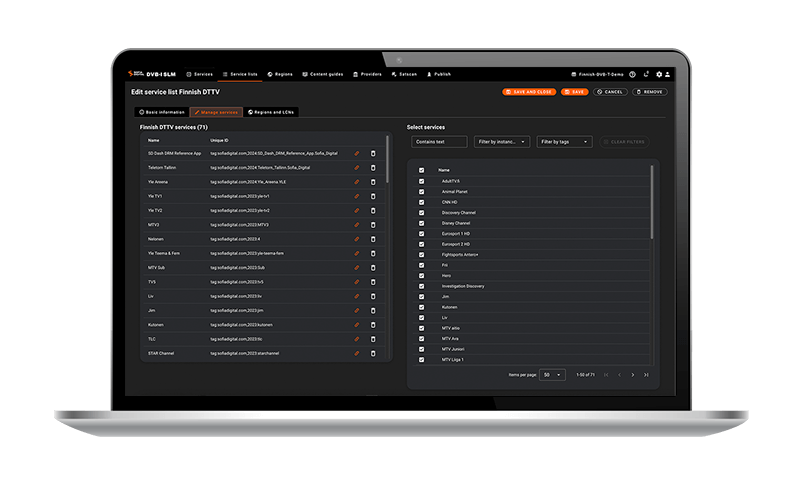
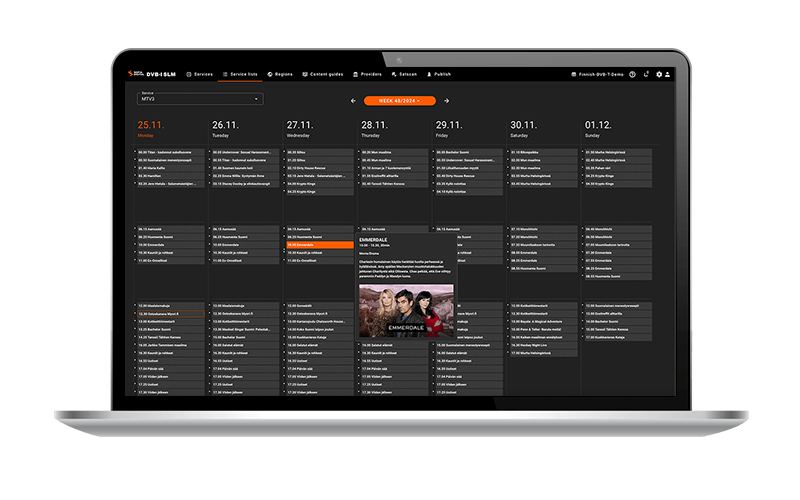
The DVB-I Service Manager is a comprehensive solution for managing DVB-I service lists and metadata, designed to streamline commercial DVB-I operations while ensuring continuity of existing broadcast solutions. It allows for efficient definition, management and integration of DVB-I services, service lists and programming information based on TV-Anytime standards.
